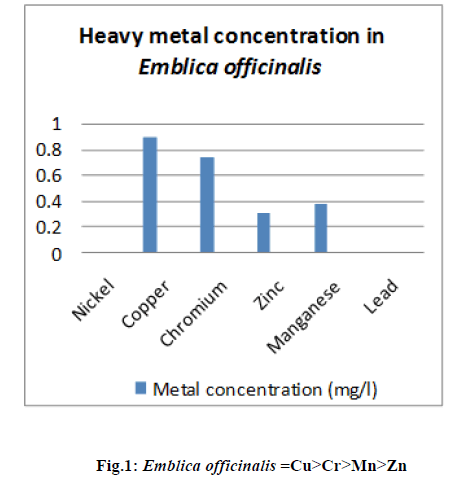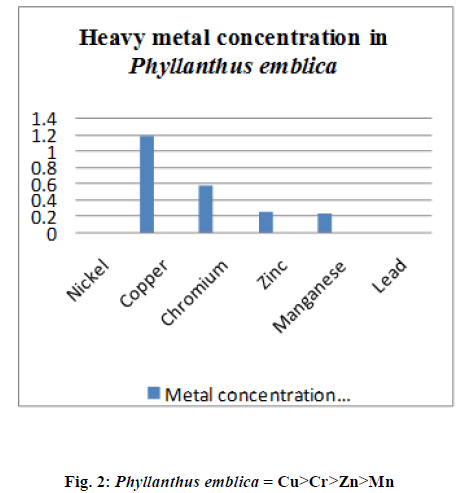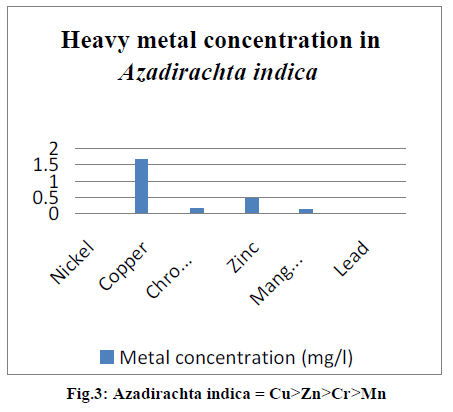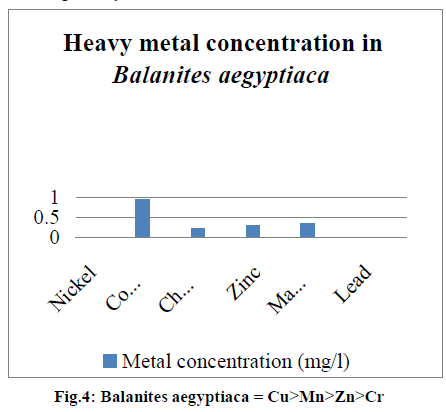Research Article - (2012) Volume 2, Issue 5
S. Gajalakshmi, V. Iswarya, R. Ashwini, G. Divya, S. Mythili and A. Sathiavelu*
School of Bio Sciences and Technology, VIT University, Vellore- 632 014, TN. India
Corresponding Author:
A. Sathiavelu
School of Bio Sciences and Technology
VIT University, Vellore- 632 014, TN. India
Medicinal plants were the potent source of therapeutic molecules to heal various diseases in the world. The amount of heavy metals in the plants was analyzed to show the potential threat of their effects to the animals and human beings who consume them as such or their derived products. The work is much more beneficial as the actual nutrient content of the medicinal plants in terms of the essential trace elements could also be identified. The concentration levels (mg/l) of the selected trace metals (Ni, Cu, Cr, Zn, Mn, Pb) were estimated in some of the important herbal plants of the Vellore district. The atomic absorption spectrophotometer was employed for the estimation of heavy metals of four different plant species that were collected from different locations within Vellore district. The plants selected for the analysis were Emblica officinalis, Phyllanthus emblica, Azadirachta indica and Balanites aegyptiaca. The metal contents in the samples were determined and was found that Emblica officinalis has the level of metals in the range of Cu>Cr>Mn>Zn, Phyllanthus emblica Cu>Cr>Zn>Mn, Azadirachta indica has Cu>Zn>Cr>Mn and Balanites aegyptiaca has Cu>Mn>Zn>Cr. Nickel and lead was found completely absent in all the four plants investigated.
Keywords
Heavy metals, Balanites aegyptiaca, Emblica officinalis, Phyllanthus emblica, Azadirachta indica.
Introduction
The human body requires a number of minerals for their growth and other activities which are obtained from plants, since plants absorb and accumulate minerals from the environment which is necessary for its growth. Plants can also accumulate metals from the environment. Among the different type of minerals, traces of Cd and Pb has been detected and reported in all plants and foodstuffs.
Medicinal plants play an important role from the ancient period as they are used in traditional medicine and also as home remedies. Environment, pollution, atmosphere, soil, harvesting and handling are some of the factors, which play a major role in contamination of medicinal plants by metals and also by microbial growth. Therefore it is necessary to measure and establish the levels of metallic elements in the herbal plants as these elements when consumed at higher levels become toxic. The World Health Organization also emphasized the need to ensure the quality of plant and its products by using modern techniques and applying suitable standards [1]. In the present study, the concentration of various metallic elements in the medicinal plants Emblica officinalis, Phyllanthus emblica L., Azadirachta indica A. Juss, Balanites aegyptiaca Del. were analyzed using atomic absorption spectrophotometry.
Emblica officinalis is commonly known as amla. The fruit of this plant is used in Indian traditional and Unani medicine. The fruit of Emblica officinalis was used as diuretic, adaptogenic, hepatoprotective, antitumor, hypocholestrolemia, antioxidant, antiulcerogenic, anti-inflammatory, antimicrobial, analgesics and antipyretic agents [2,3,4]. The fruit of E. officinalis has been found to contain tannic compounds emblicanin A and B which found to have significant invitro antioxidant activity [5].
Phyllanthus emblica L. called as “Amla” in hindi is a tree of small or moderate size with a greenish-grey bark [6]. Phyllanthus emblica L has several class of secondary metabolites used as anti-inflammatory and anti- pyretic agent by the rural population and for treating several disorders such as the scurvy, cancer and heart diseases and antineutrophilic and anti-platelet activity [6,7], anti-viral, antimutagenic, anti-allergic, anti-bacterial, gastro-protective and anti-proliferative activities [6,7,8].
Azadirachta indica A. Juss (syn. Melia azadirachta) popularly known as Indian neem (margosa tree) is well known plant in India and its neighbouring countries [9,10]. Nimbidin, a bitter crude extracted from the oil of seed kernels have been reported to have several biological activities [9]. Azadirachtin isolated from the neem seed has strong antifeedant [9,11] and antimalarial activity. A deoxygedunin compound isolated from the seed oil of the plant has been reported to exhibit moderate antibacterial activity against some strains of human pathogenic bacteria [9].
Balanites aegyptiaca Del. belongs to the family of Zygophyllaceae and it is one of the most common wild plant species [1]. The plant is called as Hingu in Hindi and Nanjundan in Tamil [12,13]. In India, the plant is found in drier areas of Rajasthan, Gujarat, Madhya Pradesh, and Deccan and also in peninsular India [14]. The plant is commonly used in traditional medicine and has been reported to have a number of cytotoxic and cytostatic compounds [15]. Balanites aegyptiaca contains saponins which have several biological activities such as antifungal, larvicidal, antimicrobial actions [16] and also anti-inflammatory properties [15].
Heavy metal uptake by the plants is therefore a main pathway of metal transfer from sediments and water to the food web. The metal uptake by the plant is determined by metal mobility and bioavailability. Most of the procedures adopted involve dry ashing or a wet digestion using nitric acid alone, or in combination with perchloric acid or hydrogen peroxide. This study adopts the procedure of overnight wet digestion with nitric acid alone for the determination of heavy metals [17]. Plants can accumulate metal in their parts and transfers it from soils into the food chain [18]. This accumulation is one of the most serious environmental concerns because of the potential harmful effects that toxic metals could have on animals and human health. Some metals like zinc, iron, copper, chromium and cobalt are toxic only at higher concentrations, while others like lead, mercury and cadmium are exclusively toxic [19].
Materials and Methods
Sampling area
The leaves of the plants Emblica officinalis, Phyllanthus emblica, Azadirachta indica and Balanites aegyptiaca were collected from poigai village near Vellore district, Tamilnadu, India and transferred in a sterile cloth bag and were transferred to the laboratory.
Sample preparation
The samples were thoroughly washed with deionized water, shade dried at room temperature for about 15 days, ground into powder with a mechanical grinder and homogenized. The samples were subsequently stored in separate sample bottles [20].
Overnight digestion with conc. HNO3
Ten milliliters of concentrated HNO3 (ultrapure 65%) was added to 1 g leaf sample and allowed to stand overnight at room temperature. The samples were then heated for 4 h at 120?C, after which the temperature was increased to 140?C. The digestion was continued at this temperature until about 1ml of acid remained. After cooling, the suspension was filtered in a 50ml volumetric flask and diluted to the mark [20]. Stock standard solutions of Copper (Cu), Chromium (Cr), Manganese (Mn), Nickel(Ni), Zinc(Zn) and Lead(Pb) containing 1000ppm of each metal were prepared by dissolving weighed quantities of appropriate dried analytical grade salts in distilled water. Calibration standards of 1ppm, 2ppm and 3ppm of each element were obtained by appropriate dilution of the stock solutions. The Cu, Cr, Mn, Ni, Zn, Pb contents were measured using flame atomic absorption spectrometry. The elements were measured under the optimum operating conditions with air-acetylene flame.
Results and Discussion
A total of 6 elements (Cu, Cr, Mn, Ni, Zn, and Pb) were determined in the powdered leaf samples of medicinal plants using atomic absorption spectrophotometer (AAS). Figure 1,2,3,4 shows the concentrations of various metals, in the analyzed herbal plants. The study revealed that all the metals were accumulated to greater or lesser extents by the 4 plant species studied, except that of nickel and lead.

Figure 1: Emblica officinalis =Cu>Cr>Mn>Zn

Figure 2: Phyllanthus emblica = Cu>Cr>Zn>Mn

Figure 3: Azadirachta indica = Cu>Zn>Cr>Mn

Figure 4: Balanites aegyptiaca = Cu>Mn>Zn>Cr
Copper is one of the essential metals which is required for the normal plant growth and development. Copper is a co-factor for metalloproteins and play a major role in several metabolic pathways. Though it is essential the excess levels of copper in the plant would inhibit its growth and alters certain cellular processes. The anthropogenic release of heavy metals into the environment by mining, smelting, manufacturing, agriculture and waste disposal technologies is a major cause for the excess accumulation of copper in nature as well as in plants [21]. Since the higher concentration of Cu becomes toxic due to its high redox properties it has to be maintained in lower levels in the body [22].
Chromium has a wide use in the industries and is considered as a serious environmental pollutant. In plants the toxicity of chromium is based on its valence state i.e. Cr (III) is less toxic when compared to Cr (VI). Chromium is not absorbed directly by plants rather it gets accumulated by carrier ions like sulfate or iron. Chromium toxicity alters the plant germination, its complete growth by affecting photosynthesis, other metabolic processes and the total dry matter production [23].
Zinc is an essential micronutrient which is involved in many biochemical reactions in the plants. It is required for the optimum crop growth and it is taken in divalent form by the plants [24]. Manganese is also an essential metallic compound that plays a vital role in the photosynthesis, nitrogen metabolism and in the formation of other compounds that are required for the plant metabolism [25].
Figure 1 shows the heavy metal content in the Emblica officinalis where the nickel and lead metals were not detected. The level of copper was found to be high in the case of the leaf sample of Emblica officinalis followed by chromium, manganese and zinc. Figure 2 shows the heavy metal content in the Phyllanthus emblica where the same copper concentration was found to be in high level when compared to that of other metal levels detected .The highest level was found to be of copper which is followed by the chromium, zinc and manganese.
The neem plant Azadirachta indica was already investigated for the presence of certain heavy metals and their concentration was found to be zinc 15.7, copper 1.12, iron 188, manganese 46.5, sodium 138, lead 0.49, potassium 19220, magnesium 5630, calcium 3543, and phosphorous 900 ppm levels [1]. In the present study Azadirachta indica showed the presence of heavy metals in the concentration of copper 1.655, chromium 0.145, zinc 0.294, manganese 0.348 ppm where the copper concentration was found to be at the maximum level followed by the manganese, zinc and chromium. The heavy metal content in the above plant was not found in large amounts. Hence, this work would support the application in the above plants due to their heavy metal accumulation capacity.
The Balanites aegyptiaca was also investigated to detect the presence of heavy metals and the report obtained would be the beneficial one as only few research activities were carried out in the above plant Balanites aegyptiaca. The copper was found to be the highly concentrated in the above plant followed by the manganese, zinc and chromium.
All the investigated plants showed the highest level of copper in the leaf parts. The heavy metal content in the plant induces stress to the plant and causes various disease, other stress related concerns, etc. So, the need to maintain the quality control of the products obtained from the medicinal plants has attained a great interest particularly in the field of pharmaceutical industries. Medicinal plants were given the standard values for the presence of heavy metal content by the World Health Organization. These measures help us to be free from metal contaminated plant products.
The source of the metal content in the soil is mainly due to the over usage of the artificial fertilizers, industrial effluent drop out to the agricultural land areas, and other man made activities. Thus, from the soil the heavy metal content were transferred to the plant parts that were consumed by the human and animal species. Hence, the bioaccumulation of the heavy metal content would attain the greater deposition in various areas of plant, animal and human. The standard levels obtained for the four metals such as copper was found to be 4-15ppm ,zinc in the wide range of 15-200ppm, followed by the manganese concentration as 2-685 ppm [1].The detection level of chromium has a limitation of about 0.12ppm per gram [20].
Comparing the obtained values to the standard limitation values, we can conclude that the copper concentration was found to be less than the detection limit and hence do not possess any harm in the products obtained out of them. Same way, the zinc and manganese concentration of the above plants were also found to be less that the standard limits. But, chromium concentration was found to be higher than that of the standard level in all the four plants out of which Emblica officinalis reaches the peak in the graph obtained.
Conclusion
The heavy metal stress in the plant affects the entire cycle of life due their accumulation in the biological species and further biomagnifications to the higher order levels thereby accumulating as much of metal stressors in the environment. Heavy metals cause stress to the cells in the body and hence affects the oxidation process called as the oxidative damage. The heavy metal content in the plant was beneficial only to a certain limit. The determination of heavy metal content in the plant depends on the factors such as the area of collection, sample collection procedures, preparation of the sample extract by various digestion methods, etc. The research has to be developed in the area of medicinal plants to produce both the therapeutic molecule and for the development of protective mechanism such as the metal absorption information through the field studies has to be done.